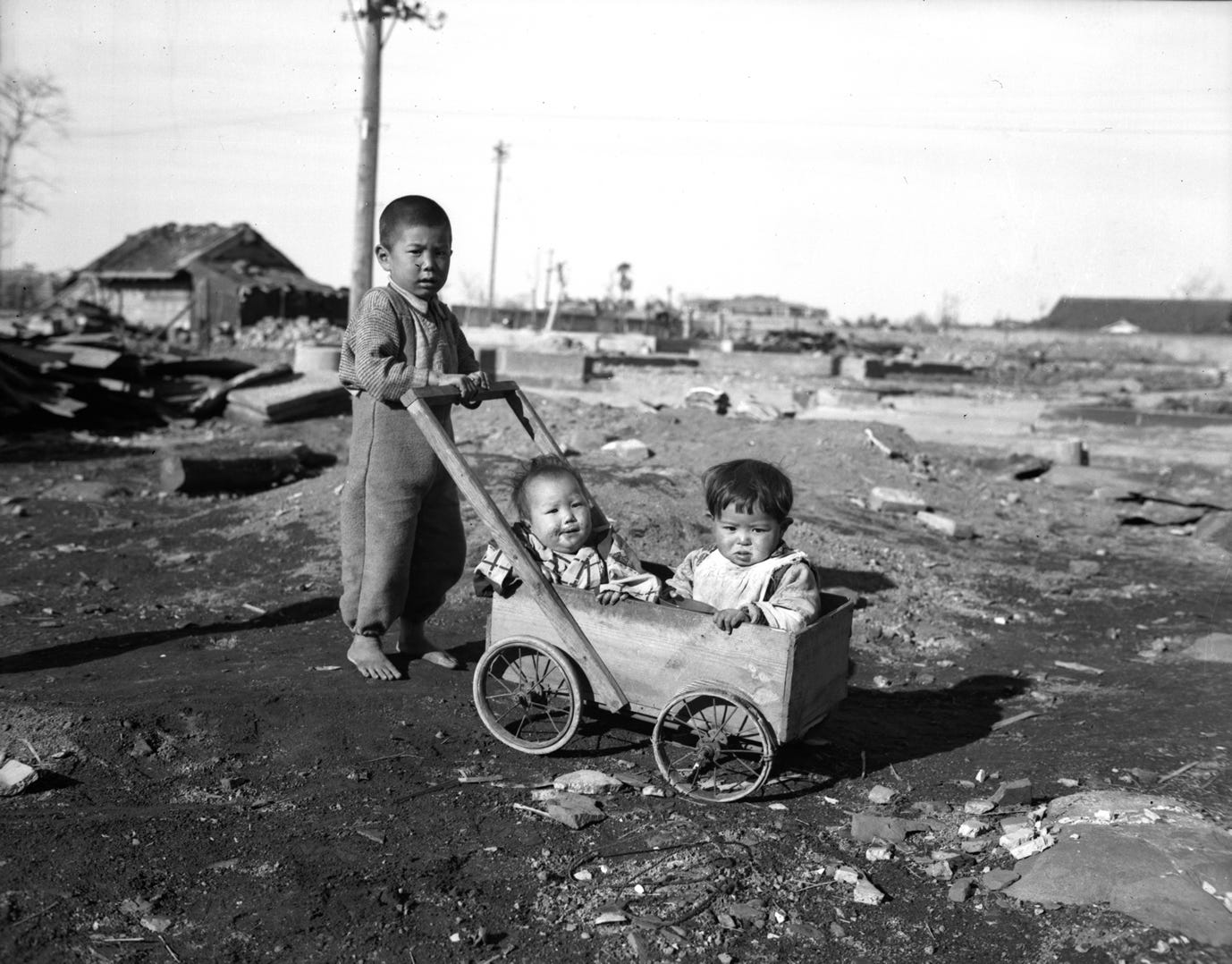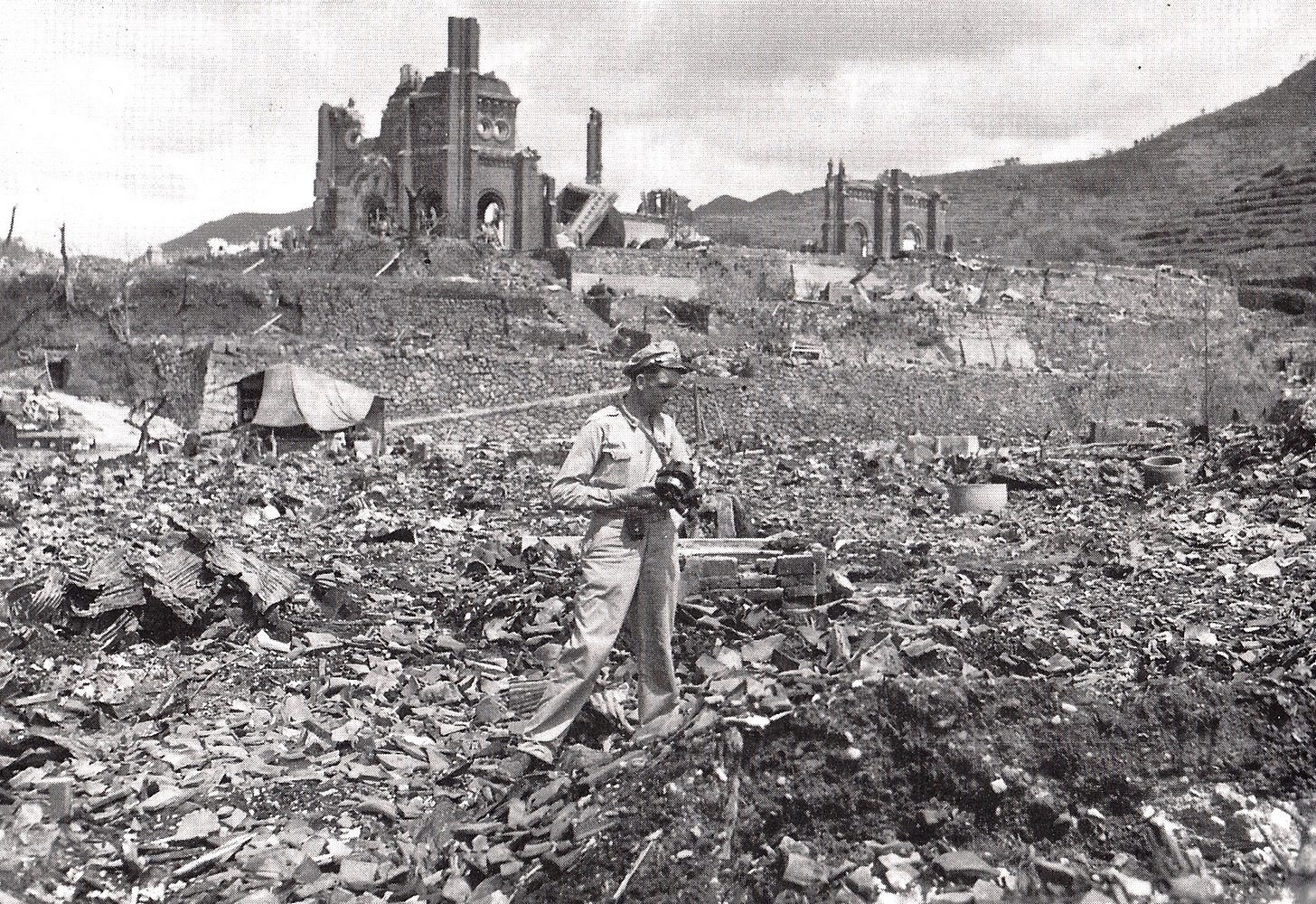Truman Failed to Pause--and the Nagasaki War Crime Followed
But few care today. Nagasaki, "the forgotten city," yet in some ways more revealing that Hiroshima.
An atomic bomb exploded over the Japanese city of Nagasaki 77 years ago on August 9, 1945, and as many as 90,000 people would die, nearly all of them civilians. Yet once again this August almost all media, official and public attention has focused on Hiroshima, site of the first atomic blast three days earlier. The attack on Nagasaki, however, was in many ways even more appalling—and revealing.
“Dropping the bomb on Hiroshima was a mistake,” Samuel I. Allison, one of the leading Manhattan Project scientists at the Met Lab in Chicago, declared years later. “Dropping the bomb on Nagasaki was an atrocity.” Indeed, some of the scientists who celebrated the Hiroshima bomb they helped invent at the Los Alamos laboratory would claim they felt physically sick on learning of the second attack. Telford Taylor, chief prosecutor at the Nuremberg trials for Nazi war criminals, asserted that while the “rights and wrong of Hiroshima are debatable” he had “never heard a plausible justification of Nagasaki.”
When Hollywood prepared its first movie drama on the bomb, MGM's The Beginning or the End, in 1946, the military and the White House forced dozens of major revisions to align the story with the official justifications for the atomic attacks. As my new book, The Beginning or the End: How Hollywood―and America―Learned to Stop Worrying and Love the Bomb, details, falsifications and propaganda shifted the focus of the film from raising dire warnings to celebrating the new weapon. President Truman even ordered a costly re-take of an entire scene to portray his decision to use the bomb in a more favorable light.
But of all these changes in the movie, perhaps the most telling and profound was that the Nagasaki bombing slowly lost its central position in the scenario and then disappeared. The final script and film would not even mention it. You could watch the MGM movie today and not have any idea we even dropped a second bomb.
Portraying, or even acknowledging, the Nagasaki tragedy, posed a special problem for the filmmakers. At the start, many Americans who’d thoroughly supported the use of the bomb against Hiroshima wrestled with the moral issues raised by the second bombing. Since then, however, whenever the attacks on Japan are recalled in the media, that one word, Hiroshima, is usually used as shorthand for the two separate catastrophes. Nagasaki sank almost into oblivion.
Few journalists even bother to visit. No one in America ever wrote a classic book called Nagasaki, or made a film titled Nagasaki, Mon Amour. “We are an asterisk,” Shinji Takahashi, a sociologist in Nagasaki, once told me, with a bitter smile. “The inferior A-Bomb city.” Kurt Vonnegut, Jr., who knew something about urban holocausts, having survived the firebombing of Dresden in World War II, would write, “The most racist, nastiest act by this country, after human slavery, was the bombing of Nagasaki.” He described it as “purely blowing away yellow men, women, and children. I'm glad I'm not a scientist because I'd feel so guilty now.”
The San Francisco of Japan, dotted with palms and largely built on terraces surrounding a deep harbor, Nagasaki has a rich, bloody history. The Portuguese and Dutch settled here in the 1500s as the city became the country’s gateway to the West. St. Francis Xavier established the first Catholic churches in the region in 1549. Urakami, a suburb of Nagasaki, became the Catholic center. Thomas Glover, an early English trader here, supplied the rifles that helped defeat the Tokugawa shogunate in the 19th century. In the Puccini opera of that name, Madame Butterfly stands on the veranda of Glover’s home overlooking the harbor and sings, “One fine day, we’ll see a thread of smoke arising.” If she could have looked north from the Glover mansion on August 9, 1945, she would have seen, two miles in the distance, a thread of smoke—with an angry mushroom cap.
By 1945, Nagasaki had become an important site for Mitsubishi’s industrial war effort, but the blockade of Japan was hindering production. Far fewer Japanese soldiers were stationed here than in Hiroshima, and only about 250 of them would perish in the second atomic bombing, along with several Dutch POWs. Nagasaki was still the Christian center in Japan, with more than 10,000 Catholics among its 250,000 residents. Most of them lived in the Urakami district, the poor part of town, where a magnificent cathedral seating six thousand had been built.
At 11:02 a.m. on August 9, the plutonium bomb known as “Fat Man” hit with the force of 22 kilotons, almost double the uranium bomb’s blast in Hiroshima. It was detonated almost directly over Urakami, more than a mile off-target. The massive cathedral there was nearly leveled, killing dozens of worshippers awaiting confession. Concrete roads literally melted. While Urakami suffered, the rest of the city caught a break. The bomb’s blast boomed up the valley but didn’t reach the congested harbor or scale the high ridge to the Nakashima valley.
If the bomb had exploded as planned, directly over the center of the city, the death toll in Nagasaki would have made Hiroshima, in at least one important sense, the Second City. Nothing would have escaped, perhaps not even the most untroubled conscience half a world away.
At least six Japanese citizens proved to be either the most unfortunate or the luckiest men in the world, or both. After surviving the Hiroshima blast they fled to their former homes in, yes, Nagasaki, where they would outlast the atomic bomb a second time.
There is this additional tragedy attached to the city: The second bomb had been meant for the city of Kokura, but it was covered with clouds, so the B-29 bomber headed for Nagasaki. There the crew found it, too, heavily obscured and the plane nearly turned away, until a small gap appeared and the bomb was released.
One has to wonder about the overwhelming impulse to almost immediately use a second bomb even more powerful than the first. Criticism of the attack on Nagasaki centers on why Truman did not step in after the success of the first to allow Japan a few more days to contemplate surrender before targeting another city for extinction. In addition, the United States knew that its ally, the Soviet Union, would join the war within hours, as previously agreed, and that the entrance of Japan’s most hated enemy at least as much as the Hiroshima bomb would likely speed the surrender. (Indeed, Truman had written in his diary at Potsdam after he secured Stalin’s promise to attack Japan in August that this meant “Fini Japs” even without use of the A-bomb.) If that happened, however, it might lead to a wider Soviet claim on former Japanese conquests in Asia.
So there was much to gain, in this view, by getting the war over before the Russians advanced. In that sense, the Nagasaki bomb was not the last shot of World War II but the first blow of the Cold War.
Whether Stalin was the main audience or not, there was no presidential directive specifically related to dropping the second bomb. General Leslie Groves, director of the Manhattan Project, had won his argument for a “one-two punch.” The atomic weapons in the U.S. arsenal, according to the official July 2 order, were to be used “as soon as made ready,” and the second bomb was ready within three days of Hiroshima. Nagasaki was thus the first and so far the only victim of automated atomic warfare. The tragedy might have been prevented if Truman and his aides had kept a closer watch on the “atomic assembly line.” They simply did not care or, to be charitable, did not take care. It is far from clear that the second bomb strongly boosted the already-surging Japanese desire to surrender after Hiroshima. None of this historical or moral complexity—or anything at all attached to Nagasaki—could be allowed to make it as far as the final script for that Hollywod drama.
In any case, after receiving reports of the massive civilian death toll in Nagasaki, Truman quickly ordered that no further bombs be used without his express permission, halting the assembly line—one bomb, one city, and tens of thousands of human lives too late.
And America’s “first-strike” nuclear policy (we can respond with nuclear weapons to a conventional attrack or even just a serious threat) remains in effect, seventy-seven years later.
—Greg Mitchell's latest book is The Beginning or the End: How Hollywood—and America—Learned to Stop Worrying and Love the Bomb.



